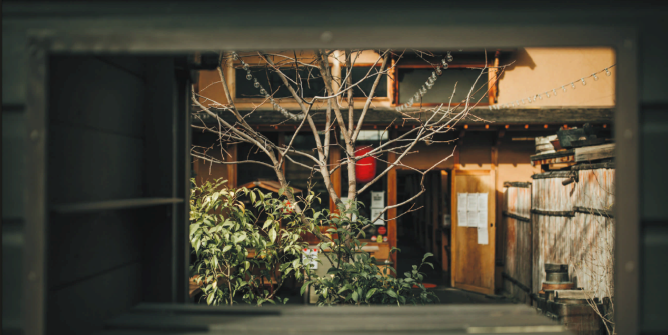Paradox On Our Plates
In San Francisco, extreme wealth and food insecurity share the same streets
WRITER Maggie Spicer
PHOTOGRAPHER Annamae Photo
Rintaro courtyard wall. Image courtesy of Annamae Photography.
In a city of 800,000—home to more restaurants per capita than almost anywhere else—San Francisco faces a troubling paradox: 130,000 residents experience food insecurity. From Michelin-starred kitchens to late-night taquerias, the Bay Area’s culinary abundance stands in stark contrast to the one in six residents who struggle daily to put food on the table. This tension underscores a deeper failure of distribution, access, and political will: if food is plentiful, why do so many go hungry?
Early efforts to bridge the gap are often improvised. Rintaro’s executive chef and owner, Sylvan Mishima Brackett, recounts installing a shelf he built against the courtyard wall for leftover food in takeaway containers—only to remove it after break-ins from “people climbing over the front wall” made the gesture untenable, highlighting how even well-intentioned acts can founder.
“This tension between food insecurity and restaurant abundance is real, but I see them as mutually exclusive rather than related,” shares Dalton Thomas, chef-turned-strategist. “Restaurants are created to serve the community; however, this is with the pressures of the capitalist systems. Income disparities, cost of rent, etc., are all working against the community in the Bay Area, so a restaurant is somewhat forced to serve the community that can support a restaurant in this environment.”
At several Bay Area farmers' markets, Foodwise provides lifelines for low-income shoppers. “We have a decades-long partnership with ExtraFood (formerly Food Runners) where produce that would otherwise go to waste at the end of the market is sent to provide meals at food shelters and neighborhood programs for food-insecure San Franciscans,” shares Executive Director Christine Farren. Through CalFresh EBT and Market Match, over $265,000 in benefits reached families last year, allowing them to “stretch their food assistance benefits while directly supporting small farms,” she adds. Still, these programs reach only a fraction of the food-insecure and require ongoing private fundraising (about $60,000 annually) to survive amid looming budget cuts.
Grocery retailers have also stepped up. Bi-Rite Market’s partnership with Food Runners—bolstered by California’s SB 1383 food-waste law–rescues “market culls” and tracks both recovery and redistribution, showcasing how legislation can spur change. Partnerships with The Women’s Building and Heart of the City Farmers Market help Bi‑Rite extend its mission of “Creating Community Through Food”, though even these alliances can only nibble at the scale of need.
The city-wide coalition FAACTS (Food & Agriculture Action Coalition Toward Sovereignty) has helped feed 70,000+ households since 2022. “Different people need to be fed differently. A food pantry doesn’t necessarily help individuals who have limited or no kitchen access, nor does it help homebound seniors,” shares Haley Nielsen, Deputy Director of Farming Hope. By preserving $75 million for community food programs and convening the first SF Food Action Summit, FAACTS illustrates what collective action can achieve—yet 130,000 still slip through the net.
But practical barriers remain. Palo Alto resident Morgwn Rimel observes, “Our local homeless community mainly seems to rely on churches and other pantries offering meals plus water from coffee shops and then collecting money to purchase cheaper food from non-food shops like CVS. What strikes me is that there are few public facilities for preparing or heating food, so it’s not even just about access to food, but also, where and how do you cook and eat?” Rimel also notes the disappearance of public drinking fountains and gathering spaces: “There is a level of basic public amenity (places to sit, gather, eat outside, and even toilets) that has been stripped away—everything is now private or has to be paid for.”
Underlying these fragmented efforts is a pervasive narrative: food insecurity is a siloed issue, easily dismissed by those insulated by abundance. Luc Sukolsky, a Bay Area native, sees a “push–pull dynamic” between the food haves and have-nots: “When you have food, you don’t think about not having it. The amount of restaurants per capita reflects the cosmopolitan lifestyles of the middle class and wealthier residents–emblematic of lifestyles defined by taste and shared experience through social media,” he proposes. “These diners value the aestheticism and exclusivity of their experience, often sidelining mutual aid initiatives that might detract from the dining experience or stretch already overstretched operators.”
“Generally speaking, it’s a place where rich people expect the worker to serve them, and that has found its way to being broken,” shares long-time resident Will Meeker. “Even with the wealthy getting paid more than they’ve ever been paid in the history of the world, they’re not prioritizing dining out. Not only can those less advantaged not afford to eat, but now the middle is hurting.”
James Freeman, former SF resident and Blue Bottle Coffee founder, reflects, “I think about the performative worthiness of San Franciscans in general and how most restaurateurs in SF can barely figure out how to pay their own bills, much less feed the 130,000 that face food insecurity. People are starving on the streets. Meanwhile, people are ordering $10,000 bottles of wine…There’s so much self-deception when those in food are working in an economic system that’s so massively unfair. It’s hard to be a restaurateur in SF, especially. Harder than most places. It’s not the responsibility of the restaurateur to feed the 130,000. But no one else is taking responsibility.”
Looking ahead, many agree real progress demands both policy and paradigm shifts. San Francisco’s culinary opulence alongside pervasive hunger underscore this truth: abundance does not guarantee equity. Only intentional distribution, durable partnerships, and political will that matches the city’s gastronomic ambitions can resolve the tension between a surplus of restaurants and the 130,000 residents who still go hungry.




